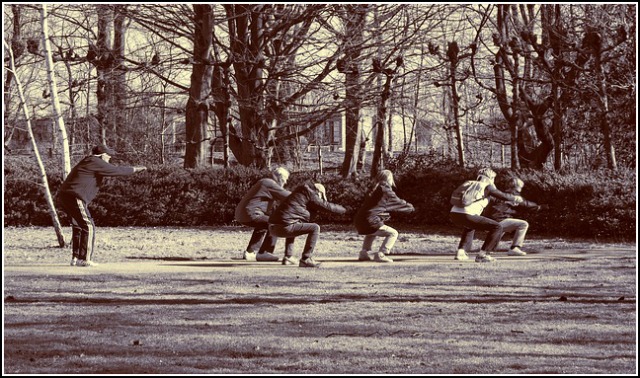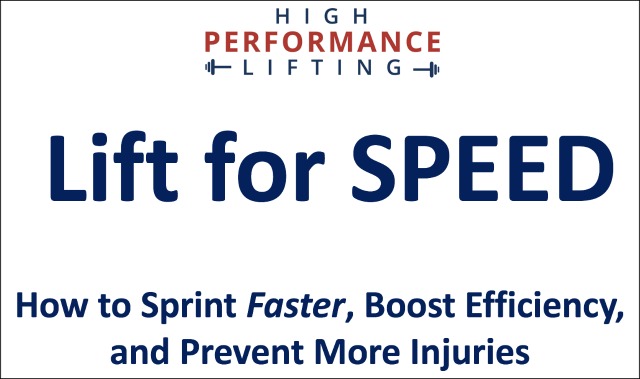If there’s one exercise that’s perfect for runners, it’s the squat. But should we squat only one way? Can we use different types of squats to get even stronger?

In high school, our track team rarely went to the gym and lifted weights. But once in awhile, a big group of us would get in the weight room and goof off (we had no idea what we were doing).
We used machines, isolated muscles, and often lifted for endurance (these are all strength training mistakes). It was haphazard and inconsistent.
Occasionally, we’d have a competition to see who could lift the most on the leg press machine (this is basically a type of squat using a machine). And I noticed something peculiar…
There were always two groups of runners that were able to press the most weight: sprinters and the faster distance runners.
What does this tell us?
- Running fast requires a high level of strength and power
- The faster you are, the stronger you likely are
- Speed, therefore, can be demonstrated in the weight room by lifting heavy weights
Like Randy Hauer once told me:
There are no weak, fast runners.
But this principle works in reverse, too: get stronger in the gym and you’ll run faster on the race course.
Stronger runners can utilize more muscle fibers for raw speed and power. The ability to recruit more fibers also helps late in a long run, race, or workout when you’re fatigued.
You’ll be able to push back the onset of fatigue, run more economically, and have the power to sprint at the end of a race.
The end result: faster finishing times and more Personal Bests!
To help you get even stronger, we have a free strength course that you’re going to love (if you’re new to strength exercises, start there).
And I also want to help you vary one of the most important exercises for runners: the squat.
The Case for Squats for Runners
The squat is a full body, compound, multi-joint exercise that strengthens nearly every muscle in your body. But it focuses on:
- quadriceps
- hamstrings
- hips
- glutes
These are the biggest and most important muscles for runners: they power your stride. When these muscles are strong and functional, you’re far less likely to get injured (and more likely to run fast).
Strength coach Tony Gentilcore knows how valuable they are for not just strength, but injury prevention:
Squats require a great amount of strength and stability in the hips and core, as well as requisite “access” to hip flexion, knee extension, and ankle dorsiflexion. Possessing the ability to perform squats is important to keep your joints healthy.
They’re also a fantastic exercise to strengthen the entire body and make it more resilient and less prone to injury.
Last I checked runners tend to be prone to nagging hip and knee injuries. Squats can help reduce the instances of these injuries from happening in the first place.
A prior podcast guest, Tony writes about all things strength and conditioning for a global audience at his website here.
From an injury prevention perspective, squats are highly beneficial because they strengthen more than just your muscles. They also strengthen the bones, ligaments, and insertion of the tendons in your legs.
Moreover, the movement of a squat is highly specific to running: after all, running simply a series of highly coordinated one-legged squats.
Stronger squatters will become faster (and less injury-prone) runners.
Are different kinds of squats beneficial?
Spoiler: yes, of course!
Even though different types of squats primarily work the same muscles, the emphasis of each exercise is slightly different. That means muscle development will be different as well.
For example, a sumo squat has different foot positions than a traditional bodyweight squat, leading it to emphasize different muscles. While both exercises work the same muscles, the sumo squat places more stress on the inner thigh adductors and glutes.
With different mechanics, you get different stresses and levels of mobility and range of motion.
The end result? A stronger, more mobile, faster runner.
This shouldn’t be too surprising as we know this intuitively from running: faster running recruits more muscle fibers overall, better engages the glutes, and requires a larger range of motion.
Strength training exercises are exactly the same – different kinds of squats are going to offer slightly different results.
But make no mistake: all squats are beneficial!
5 Types of Squats
Incorporating more variety in the types of squats you perform is going to give you better results.
And I want you to have better results!
I filmed a video in sunny Denver, Colorado showing you five of my favorite kinds of squats:
You don’t need to watch me squat all day to figure out the movement. Below are descriptions of each exercise:
Bodyweight Squat: Stand with your feet about shoulder width apart and toes facing straight ahead or at a slight angle. This is the starting position. Begin the movement by flexing your knees and hips, sitting back with your hips. Continue until your thigh is about parallel to the ground and then reverse the motion until you are back to the starting position. Push your knees out and keep your head and chest up during the entire movement.
Prisoner Squat: Stand with your feet about shoulder width apart, toes facing straight ahead or at a slight angle, and your hands behind your head. This is the starting position. Begin the movement by flexing your knees and hips, sitting back with your hips. Continue until your thigh is about parallel to the ground and then reverse the motion until you are back to the starting position. Push your knees out and keep your head and chest up during the entire movement.
Sumo Squat: Stand with your feet wider than shoulder-width apart and your toes turned out. This is the starting position. Begin the movement by flexing your knees and hips, sitting back with your hips. Continue until your thigh is about parallel to the ground and then reverse the motion until you are back to the starting position. Push your knees out and keep your head and chest up during the entire movement.
Narrow Squat: Stand with your feet together and your toes pointing straight ahead. This is the starting position. Begin the movement by flexing your knees and hips, sitting back with your hips. Continue until your thigh is about parallel to the ground and then reverse the motion until you are back to the starting position. Push your knees out and keep your head and chest up during the entire movement.
ATG Squat: Stand with your feet about shoulder width apart and toes facing straight ahead or at a slight angle. This is the starting position. Begin the movement by flexing your knees and hips, sitting back with your hips. Continue until you can’t squat any lower – your butt should be as close to the ground as possible. Reverse the motion until you are back to the starting position. Push your knees out and keep your head and chest up during the entire movement.
Now, you have a toolbox of many types of squats to use in your strength training!
When to Use Squat Variations
These types of squats can be used anytime that you have bodyweight squats on your strength training schedule.
Mix and match the exercises so you become comfortable and proficient at each of the types of squats included in this article. When you start to feel like they’re easy, you know you’ve dramatically improved!
Each type of squat will subtly train your mobility, strength, and athleticism in nuanced and different ways.
As I mentioned in the video above, bodyweight squats are very good at building strength in a runner-specific way – but they’re not ideal.
In a perfect world, your squats will be weighted. Weight training for runners helps you build more strength and most importantly, helps you run faster.
Tony Gentilcore recognizes that this is the real goal of lifting for performance:
Moreover, runners can always benefit from more force. Squats help make people stronger, which in turn helps to generate more force. As a runner, if you’re able to put more force into the ground to propel yourself forward, the likelihood you’ll see faster race times is pretty high.
Please don’t tell me squats will make you slower. They won’t.
To get stronger for performance (in other words, if you want to lift for speed), you’ll need to get in the gym. Heavier weight is a stronger stimulus for adaptation, giving you more results in both the short- and long-term.
If you’re not sure exactly where to start, we’ve got you covered.
Sign up here and you’ll get our best strength training advice:
- 3 types of sub-par lifting that will waste your time and not give you the best results
- The scientifically proven benefits of lifting heavy weights
- An example of a perfect power movement for runners
- Case studies, lessons learned, and a lot more
It’s helpful to know that the fastest runners in the world spend time in the weight room getting stronger. Elites aren’t just doing bodyweight squats…
They know that speed = power so they’re always improving their ability to generate force.
You can do the same. Let me show you!
